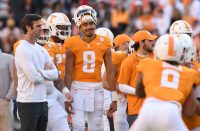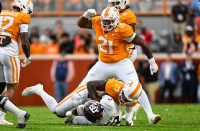If you’re looking for a scenario where Tennessee upsets Oklahoma, the most straightforward one goes something like this: the Vols use their star-studded offensive line to go right at Oklahoma’s inexperienced defensive line, and Eric Gray/Ty Chandler/player to be named later do the heavy lifting for Tennessee’s offense. The Sooners graduated three interior linemen, and defensive end Ronnie Perkins is still looking at a suspension; OU will be relying on a lot of (highly regarded) junior college talent right away. If Tennessee wants to help Jarrett Guarantano as much as possible, a strong running game can be his best friend, and Oklahoma’s rebuilding defensive line makes for an appealing early target.
This kind of gameplan isn’t just something that sounds good on paper. It’s one Jim Chaney is well-versed in. As Tim Jordan is no longer with the program, one of the biggest questions becomes, “Who else can help carry this kind of load?”
Chaney, like all good coordinators, adapts and evolves. We looked at his career between stops in Knoxville in our 2019 Gameday on Rocky Top preseason magazine, and republished that story on our site a few weeks ago. After lighting it up through the air with the Vols in 2012, Chaney leaned heavy on the ground game with just two backs at Arkansas in 2014. Jonathan Williams had 211 carries for 1,190 yards; Alex Collins had 204 for 1,100. That’s 16 carries per game for each; no one else on the roster had more than 31 carries the entire year.
In week three that season, Arkansas went to Texas Tech looking for its first power five win in two years. And the Razorbacks won 49-28, with Brandon Allen putting the ball in the air just 12 times. Collins had 27 carries for 212 yards, Williams 22 for 145, and Arkansas kept the ball for more than 40 minutes, punting once.
Tennessee’s current talent level is somewhere between that Arkansas team and Chaney’s second year at Georgia in 2017, when Jacob Eason was hurt in week one and the Dawgs needed to help Jake Fromm as much as possible. In a Top 20 showdown in Starkville in week four, Georgia announced their presence with authority in a 31-3 beat down. Fromm threw just 12 times, completing nine of them for 201 yards. He was able to put up those kind of numbers because Georgia ran it 42 times for 203 yards, with four different backs receiving at least seven carries.
Fromm’s stat line in Georgia’s 41-0 win in Knoxville the following week? Only 7-of-15 for 84 yards with a touchdown and a pick. But Georgia ran it 55 times for 294 yards, with five different backs receiving at least five carries. In the Cocktail Party, Fromm went 4-of-7 for 101 yards while Georgia ran for 292 more.
Tennessee’s backs have work to do to get in the same conversation with Nick Chubb and Sony Michel. But their carry distribution is noteworthy, even on such a successful run-heavy team: Chubb averaged 15 carries per game, Michel just 11, and the Dawgs supplemented them with 81 carries on the year for freshman D’Andre Swift, 50 from Elijah Holyfield, and 61 from Brian Herrien. Isaiah Wynn was a second-team All-American and first round draft pick at offensive tackle, but the whole of Georgia’s 2017 offensive line didn’t enter the season with the kind of expectations Tennessee’s 2020 line will inherit. So Eric Gray and Ty Chandler don’t have to be Chubb and Michel for this kind of thing to work.
And this kind of thing also allowed Jake Fromm to get better as the year went on. The Dawgs were successful pounding it this way early, and Fromm was at his best in the SEC Championship Game (16-of-22 for 183 yards and two touchdowns) and the playoff semifinal with Oklahoma (20-of-29 for 210 yards and two touchdowns). Guarantano certainly enters the year with higher expectations than Fromm did in 2017.
So, could Tennessee pull something like this off without Tim Jordan, or a breakout effort from a third back?
Last year Chaney and the Vols went with the hot hand: Ty Chandler averaged 10.4 carries per game, Tim Jordan 8.7, and Eric Gray 7.8. Jordan missed the BYU game (see Chandler’s numbers below), meaning on the year Chandler essentially got 40% of the carries, Gray and Jordan 30% each. And they each had a standout game:
- Ty Chandler vs BYU: 26 carries for 154 yards (5.9 ypc)
- Tim Jordan at Alabama: 17 carries for 94 yards (5.5 ypc)
- Eric Gray vs Vanderbilt: 25 carries for 246 yards (9.8 ypc)
Last season the Vols ran the ball 56.2% of the time (data via SportSource Analytics). Chaney’s 2017 Georgia offense ran it a whopping 68.7% of the time, though you’re certainly getting some fourth quarter blowout carries in there. The 32 passes Fromm attempted in the national title game were his season high. Brandon Allen, playing from behind far more often at Arkansas in 2014, averaged 26 passes per game.
Guarantano’s peak last fall included his best performance: after throwing it 40 times in the opener against Georgia State, he hit that number again at Missouri with 415 yards behind it. In 2018 the Vols were at their best with lower passing numbers as well: 32 attempts in the win at Auburn, just 20 in the win over Kentucky.
If Gray and Chandler stay healthy, the Vols may only need around five carries per game from someone else. Quavaris Crouch got seven short-yardage carries last season (for nine yards and two touchdowns, some straight up fullback stuff). Could the Vols got to him in those situations more often? Carlin Fils-aime is still on the roster. And local product Tee Hodge could get early opportunities as well.
Running it 56.2% of the time is about where the Vols have been the last four years, always between 56-59%. The 2015 team ran the ball 62.4% of the time, leading to plenty of, “Will they let Dobbs throw downfield?” questions this time four years ago. We already know they’ll let Guarantano do that. But if Tennessee elects to lean into the run behind their star-studded offensive line, Guarantano’s chances to go deep will increase. And it may be Tennessee’s best path to victory.




